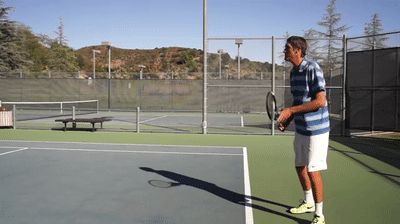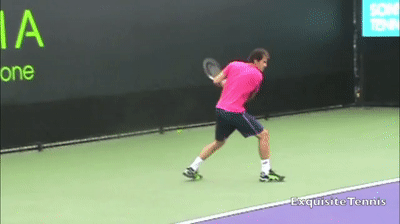This post from another thread shows a comparison and analysis of poster Mojo28's one hand backhand drive and Gasquet's from the start of the forward racket motion. Note the chest and upper arm of the high level backhand.
[ Note for new readers - It is necessary for this analysis to understand the defined joint motions of
internal shoulder rotation (ISR) and
external shoulder rotation (ESR). The upper arm between the shoulder joint and elbow does not go anywhere, it just spins like a top around the upper arm's center line.]
Pictures of each frame of Mojo's video. The time scales are in milliseconds with "0" milliseconds being impact. -267 milliseconds is about 1/4 second before impact.
I point out differences between better high level strokes and the poster's strokes. A poster can select a high level stroke and copy it or use some other stroke model. Or, go with instruction or on their own without a model or instruction.
Mojo's ball is lower than Gasquet's. Compare similar ball heights for better analysis.
Frame at -267 ms. It looks as if at 267 milliseconds before impact the OP has turned his shoulders back to about the same angle as Gasquet has. Compare also shoulder turn angles at impact, at Frame -0 ms. The positions of the arms and rackets are different. Gasquet's racket has not come down and is still in front of his body. Is Mojo copying some other backhand stroke? Mojo has also done pronation to bring the racket down. Impression is that Mojo is doing his own thing. ? (To see angles more accurately, the cameras for both backhands need to view the players and courts from the same angle. Wear tight fitting clothes or a short sleeve shirt to better see the upper arm, elbow angle, etc.)
Frame at -233 ms. Mojo has brought his racket farther down. Gasquet's racket has gone up slightly. Mojo's elbow looks bent more and his upper arm (between the shoulder and elbow) has more downward rotation (ISR). Compare ISR angle to ISR angle as these frames progress.
Frame at -200 ms. Mojo's racket is still lowering and low. Gasquet's is just starting to lower.
Frame at -167 ms. Mojo's upper arm is down from the shoulder joint. Gasquet's upper arm is more across the chest.
Frame at -133 ms. Mojo's racket still lowering. Gasquet's now lowering with more rapid drop.
Frame at -100 ms. Mojo's upper arm is down at the chest. Gasquet's upper arm is more across the chest. Gasquet now appears to have started more upper body turn. I believe that to produce this early arm and racket acceleration that Gasquet is pressing hard on his upper arm with his chest powered by the forces of turning his upper body.
If a credit card were between his chest and upper arm, would it be pressed tightly? How much upper arm pressing Mojo is doing this is not clear (due to the obscuring shirt and arm angle). But his upper body does not appear to be turning as rapidly.
Frame at -67 ms. The racket head speed developed by any rotation depends on the location of the axis of rotation and the distance out from that rotation axis. Look at the arm and racket angle and the distance out from the location of the rotation axis (guessed for now). It looks as if Mojo's arm angle is not favorable for racket head speed. Also, Mojo's racket is already much more rotated toward the ball trajectory. Gasquet's racket is >180° back from the ball's trajectory. Gasquet's upper arm is pressed to his chest as discussed.
Frame at -33 ms. Look at the racket to ball trajectory angle for Mojo, 45°? Look at the racket to trajectory angle for Gasquet still >180°. The total turns of Mojo's and Gasquet's upper bodies from Frame -267 ms seem somewhat similar, similar average speeds. The upper arm and racket have been used differently. Another motion - now look at the elbow bones and estimate the angular position of internal shoulder rotation, or axial rotation of the upper arm in the shoulder joint. Compare ESR from -33 ms to -0 ms.
Frame at -0 ms closest to impact. The big differences from Frame -33 ms to Frame -0 ms are the angular movement of Gasquet's racket and the much larger movement of his hand in the forward direction in comparison to Mojo. Also, Mojo's racket is open and Gasquet's is closed at impact. Possibly the ball height was a factor in how closed the racket was.? Now look at Gasquet's elbow bones and compare them to Frame -33 ms. Gasquet has done rapid external shoulder rotation (ESR) from Frame -33 ms to Frame -0 ms. That has moved the racket up and added to the topspin that the upward hand path already would have produce without ESR. Because Gasquet brought down his racket earlier with a near straight arm, it caused rapid ISR and pre-stretched his ESR muscles, he is using those stretched muscles in this frame. (Search the Stretch Shorten Cycle).
Frame at +33ms after impact. Mojo's hand and racket go more forward. Gasquet's goes more forward and up. ESR has continued.
Frame at +67 ms. Comparison of the follow throughs.
Video.















